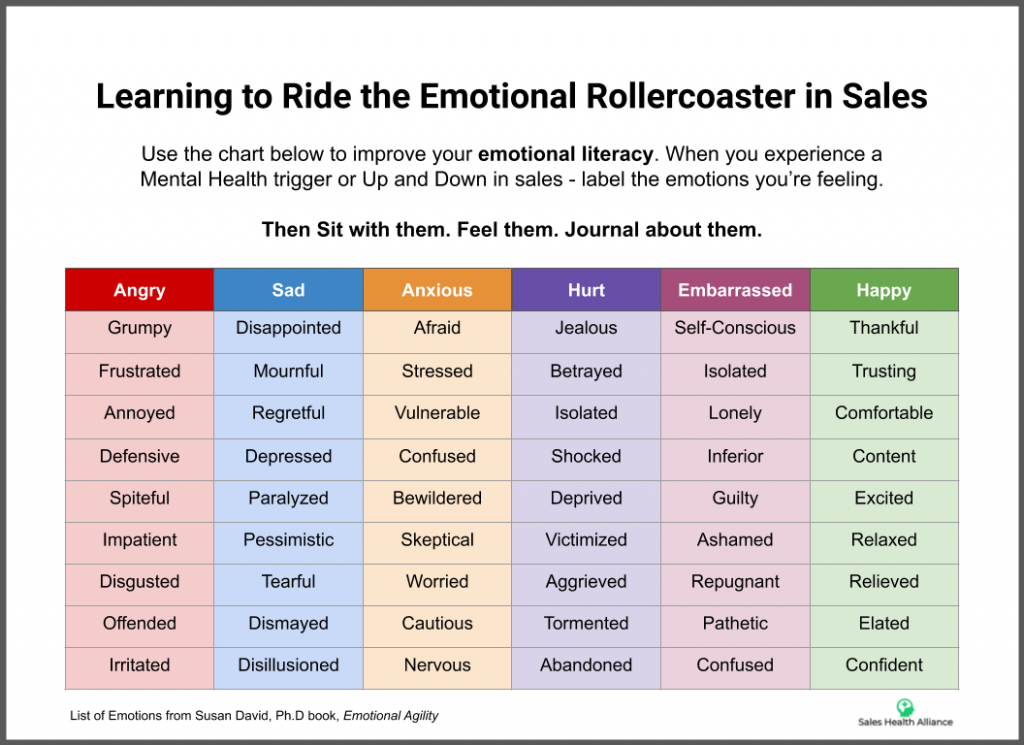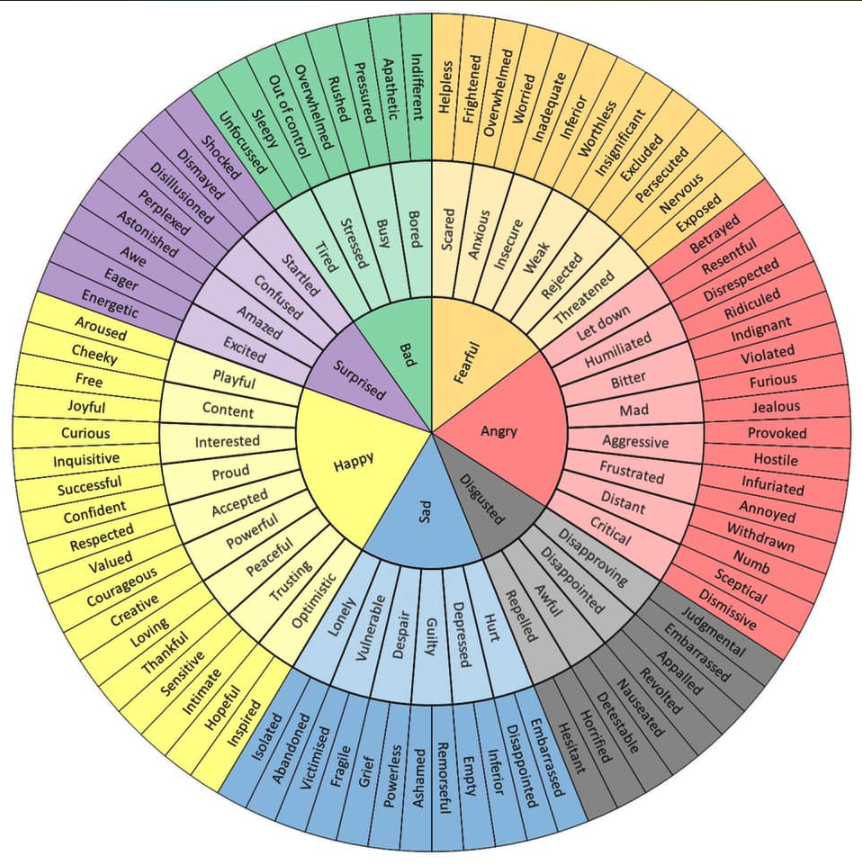Sales is often described as an emotional rollercoaster as salespeople can experience various Mental Health trigger events throughout their day.
In one moment they may be feeling happy, excited or thankful after a deal closes. Then half an hour later they may be feeling anxious, sad or hurt after a client ghosts them, leaving them scrambling to catch up on their sales KPIs.
Navigating these extreme Highs and extreme Lows can be intoxicating and addictive on some days. Most of the time it is exhausting and overtime it will start to dramatically impact our Mental Health and well-being.
Without effective strategies to respond to these emotions, we can burnout or react with bad habits that will impact our sales performance.
My Experience Riding the Emotional Rollercoaster
Early in my sales career when the clock would strike 5pm, I would leave the office not knowing what I was feeling. All I could feel was this uncomfortable buzzing feeling which was all the anger, happiness, anxiety and sadness rolled into one big ball of emotion.
Rather than explore these emotions I’d numb them.
I’d party, drink alcohol and play hours of video games to try and escape how I was feeling because my emotions scared me. I wasn’t able to identify how I was feeling so I kept running and the big ball of emotions kept growing. Eventually it would become too much to handle and I’d experience a panic attack.
This was not conducive to helping me sell at a high level each day.
The thing about emotions is they don’t go anywhere. The harder we work to bury and push them away – the harder they’ll fight back. This means we need to be comfortable feeling them if we want to have a healthy relationship with ourselves and a long career in sales.
The first step in better understanding our emotions is improving our emotional literacy.
What is Emotional Literacy?
There are various definitions of emotional literacy, but I like Tian Dayton’s the most:
“Emotional literacy is our ability to put feelings into words so that those feelings can be understood.”
Very few of us in sales can do this effectively. We are only “literate” in naming and describing a few emotions. Usually these emotions are the really strong and powerful ones that we tend to feel most often.
We all know how it feels to be angry, anxious, hurt, sad, embarrassed and happy. We can label these emotions and communicate those feelings to others so that our friends, family and colleagues can understand us.
Past this point we get stuck.
Encountering a trigger event in sales can make us feel several different emotions at the same time. Some big and some small. Rarely are we moving past the stronger emotions and describing the more sensitive ones we are feeling like these:
I’m experiencing defensiveness after that meeting with my manager.
Missing target made me experience loneliness.
I’m experiencing inferiority pacing behind to my peers.
When that buyer ghosted me it made me experience skepticism.
These types of emotions are rarely included in our vocabulary and each one will feel slightly different. This makes us emotionally illiterate, which means we’ll have trouble putting our emotions into words. This is extremely frustrating and results in our emotions getting stuck together.
To help us untangle these emotions we need to improve our emotional literacy. This requires better labeling of these quieter and more sensitive emotions. These smaller emotions can be equally as troublesome as the stronger emotions we’re more familiar with when they bundle together.
Until we learn how to put our feelings into words, our emotions will continue to scare us and cause us to look for ways to numb them. We’ll also be unable to effectively communicate how we’re feeling which will damage our relationships with others.
Project Mamba: Stop Letting Stress Impact Your Commission Check
Riding Waves On The Emotional Rollercoaster
In a previous article I explained how it is important for us to treat our emotions like a wave. We are not the wave and we are not the energy that is tied to them. We are simply experiencing the wave of emotion passing through us.
When these waves of emotion get bundled together – the water gets choppy. Before we know it can feel like we’re drowning or like that buzzing feeling I described a few paragraphs up.
The first step is the hardest part of getting these emotions to release – labeling each emotion and pulling them apart. Use the image below to help you do this and move past the stronger surface level emotions you might be feeling like Anger or Anxiety. These strong surface level emotions are clues that we need to dig deeper into how we’re feeling and work on our emotional literacy.
It may also be a good idea to read the full stress relaxation exercise that helps walk you through this. The book Emotional Agility by Susan David will also support you in this process and where the list of emotions below is from.

A friend of mine sent me the emotions wheel below after writing about this topic online. If you know who the creator is please email me at [email protected] so I can provide credit to them
Write About What You’re Feeling
After you’ve labeled your emotions – sit with them so you learn how they feel. Then write about what you learned from them. Emotions are like tiny messages that help us learn more about ourselves.
As your emotional literacy improves – you’ll feel more comfortable approaching some of the more uncomfortable emotions and listening to what they have to say. It’s important to approach these emotions with curiosity and compassion to stop yourself from judging how you feel.
There are major benefits to putting the work in and journaling for 20 minutes a day for three days a week.
Fascinating research by James Pennebaker found that people who wrote about emotionally charged experiences, significantly improved their physical and Mental Health. They were happier, less depressed and less anxious. People also had lower blood pressure, improved immune function, better relationships and more success at work.
Exploring your inner world is scary at first, but growing through this discomfort will always win out over trying to numb our emotions.
Exercise: Emotional Rollercoaster 1-on-1
Sales leaders love to ask sales reps this question in their weekly 1-on-1:
“How are you feeling this week?”
The problem here is neither the sales leader nor the sales rep knows how to truly answer this question. Even in the most supportive environments, most reps or managers only know how to communicate if they’re feeling anxious, angry, sad, hurt, embarrassed or happy.
A better question would be:
“What type of emotions have you experienced this week? What experiences created those emotions?”
Both parties need to work on their emotional literacy together. Work on fine tuning and identifying some of the smaller, more sensitive emotions as a team. This will improve communication, build trust and allow both leader and rep to learn how to better support each other.
Plus it help you build confidence and will make the emotional rollercoaster more fun to ride when you can express how you’re feeling.
To help you do this – you can access a free download of the image in this post by clicking the link below. Print it out and keep it somewhere visible in your workspace. This should make it easier to pinpoint how you’re feeling and identify why you might be feeling that way. Practicing this exercise consistently will improve your Mental Health and lead to better sales performance.
Project Mamba: Stop Letting Stress Impact Your Commission Check
Download Emotional Literacy One Pager
About The Author

Jeff Riseley is currently the Founder of the Sales Health Alliance and Mental Health Advocate. With over a decade of sales experience – Jeff understands the importance of Mental Health in achieving peak sales performance.
Jeff combines his sales (Sales Knowledge Institute) and Mental Health expertise to improve sales performance through a mix of sales mentorship and mental health best practices. His strategies have helped sales teams improve their sales process, while helping them become more motivated, resilient and better equipped to tackle stressful events within sales.
He is currently delivering these strategies through on-site workshops, coaching and speaking engagements. To explore working with Jeff contact him at [email protected]





10 Comments
Pingback: Five Dysfunctions Of Mental Health - Sales Health Alliance
Pingback: Podcast: Overcoming Anxiety in Sales - Sales Health Alliance
Pingback: Why Psychological Safety In Sales Is Important - Sales Health Alliance
Pingback: What's Holding You Back In Sales? - Sales Health Alliance
Pingback: The Mental Health Traffic Light In Sales - Sales Health Alliance
Pingback: How To Manage Failure In Sales - Sales Health Alliance
Pingback: How To Master Your Sales Anxiety - Sales Health Alliance
Pingback: How Resentment Kills Motivation In Sales - Sales Health Alliance
Pingback: How To Overcome Limiting Beliefs In Sales And Life - Sales Health Alliance
Pingback: 3 Ways To Stress Less In Sales - Sales Health Alliance